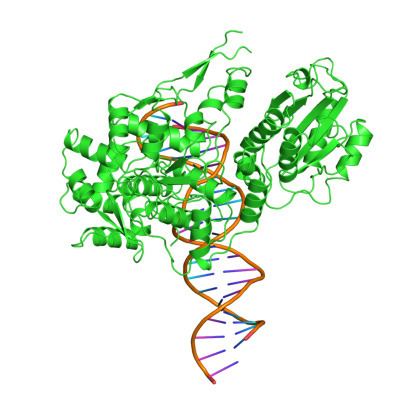Symbol Endonuc-FokI_C Pfam clan CL0415 SCOP 2fok | Pfam PF09254 InterPro IPR015334 SUPERFAMILY 2fok | |
 | ||
The enzyme FokI, naturally found in Flavobacterium okeanokoites, is a bacterial type IIS restriction endonuclease consisting of an N-terminal DNA-binding domain and a non-specific DNA cleavage domain at the C-terminal. Once the protein is bound to duplex DNA via its DNA-binding domain at the 5'-GGATG-3' recognition site, the DNA cleavage domain is activated and cleaves, without further sequence specificity, the first strand 9 nucleotides downstream and the second strand 13 nucleotides upstream of the nearest nucleotide of the recognition site.
Contents
Its molecular mass is 65.4 kDa, being composed of 587 amino acids.
DNA-binding domain
The recognition domain contains three subdomains (D1, D2 and D3) that are evolutionarily related to the DNA-binding domain of the catabolite gene activator protein which contains a helix-turn-helix.
DNA-cleavage domain
DNA cleavage is mediated through the non-specific cleavage domain which also includes the dimerisation surface. The dimer interface is formed by the parallel helices α4 and α5 and two loops P1 and P2 of the cleavage domain.
Activity
When the nuclease is unbound to DNA, the endonuclease domain is sequestered by the DNA-binding domain and is released through a conformational change in the DNA-binding domain upon binding to its recognition site. Cleavage only occurs upon dimerization, when the recognition domain is bound to its cognate site and in the presence of magnesium ions.
Exploitation
The endonuclease domain of FokI has been used in several studies, after combination with a variety of DNA-binding domains such as the zinc finger (see zinc finger nuclease), or inactive Cas9
One of several human vitamin D receptor gene variants is a single nucleotide polymorphism in the start codon of the gene which can be distinguished through the use of the FokI enzyme.
